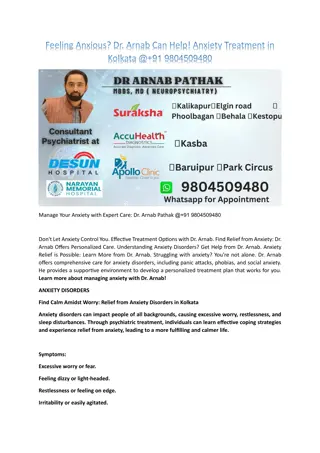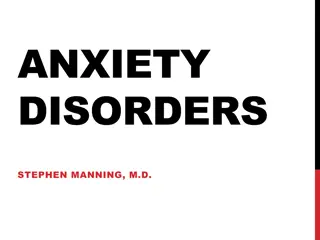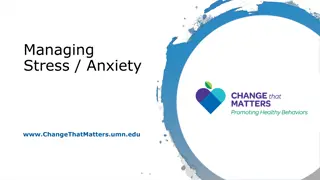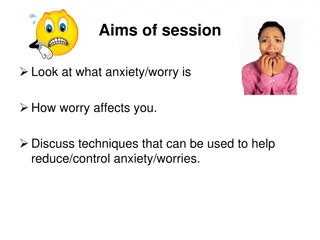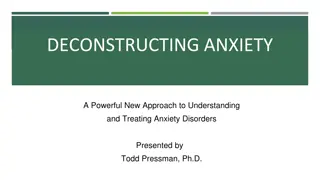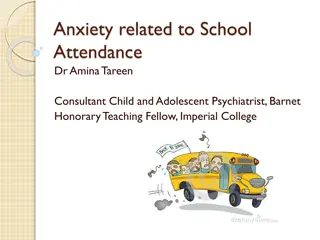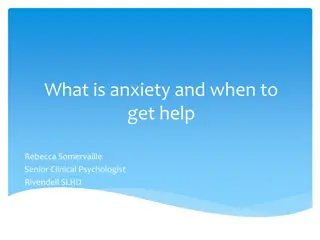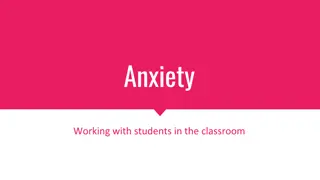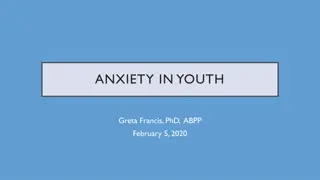Overview of Anxiety Disorders and Antianxiety Drugs
Anxiety disorders are conditions characterized by excessive worry and fear that can interfere with daily life. Common types include generalized anxiety disorder, panic disorder, phobias, and OCD. Treatment options include psychotherapy and anxiolytic drugs such as benzodiazepines, 5HT1A agonists, beta-adrenergic blockers, and tricyclic antidepressants. These drugs work through various mechanisms to reduce anxiety symptoms. Understanding the classification, mechanism of action, pharmacokinetics, and pharmacological actions of antianxiety drugs is essential for effective management of anxiety disorders.
Download Presentation

Please find below an Image/Link to download the presentation.
The content on the website is provided AS IS for your information and personal use only. It may not be sold, licensed, or shared on other websites without obtaining consent from the author. Download presentation by click this link. If you encounter any issues during the download, it is possible that the publisher has removed the file from their server.
E N D
Presentation Transcript
Drugs used for anxiety and panic disorders ILOs Define some types of anxiety disorders Classify types of drugs used for treatment of anxiety Discuss the different characteristics of antianxiety drugs
What is anxiety ? What is anxiety ? Physical and emotional distress which interfere with normal life.
Types of anxiety disorders Types of anxiety disorders 1- Generalized anxiety disorder OCD handwash.jpg panic_tn 2- Panic disorder 4-Post traumatic stress disorder 220px-Messie_mess_1 3- Phobia 5- Obsessive compulsive disorder
Treatment of anxiety Treatment of anxiety Psychotherapy Anxiolytics
Classification of anxiolytic drugs: Classification of anxiolytic drugs: 1-Benzodiazepines ( BDZ ). 2-5HT1A agonists. 3-Beta-adrenergic blockers 4-5HT reuptake inhibitors 5-Tricyclic Antidepressants
Mechanism of Action Mechanism of Action Benzodiazepines act by binding to BZ receptors in the brain action in the brain enhance GABA
PHARMACOKINETICS PHARMACOKINETICS Can be classified according to the duration of Lipid soluble action into short, medium & long- acting Well absorbed orally, Can be given parenterally Chlordiazepoxide- Diazepam (IV only NOT IM) Widely distributed Excreted in milk (neonatal depression). Cross placental barrier (Fetal depression)
Pharmacological Actions Pharmacological Actions Anxiolytic action. Depression of cognitive and psychomotor function Sedative & hypnotic actions Anterograde amnesia Minimal depressant effects on cardiovascular system & respiratory system Some have anticonvulsant effect: Clonazepam, diazepam.
Therapeutic Uses Therapeutic Uses Anxiety disorders: Short term relief of severe anxiety General anxiety disorder Obsessive compulsive disorder Panic attack with depression Alprazolam (antidepressant effect) Sleep disorders (Insomnia). Triazolam, Lorazepam, Flurazepam Treatment of epilepsy Diazepam Lorazepam In anesthesia Preanesthetic medication (diazepam). Induction of anesthesia (Midazolam, IV)
Adverse Effects Adverse Effects Ataxia (motor incoordination) Cognitive impairment Hangover: (drowsiness, confusion) Tolerance & dependence Risk of withdrawal symptoms(Rebound insomnia, anorexia, anxiety, agitation, tremors and convulsion)
Adverse Effects Adverse Effects Toxic effects: respiratory cardiovascular depression in large doses. : Scotch Whisky (aka).jpg
Drug Drug - -drug interactions drug interactions Examples CNS depressants Alcohol & Antihistaminics effect of benzodiazepines Cytochrome P450 inhibitors Cimetidine & Erythromycin t of benzodiazepines Phenytoin & Rifampicin t 1/2 of benzodiazepines CYT P450 inducers
Benzodiazepine antagonist Benzodiazepine antagonist Flumazenil Binds competetivly to GABA receptors displacing benzodiazepine Has a short plasma half life repeated dosing Used in benzodiazepine overdose Precipitates withdrawal symptoms in benzodiazepine addicts
5 5HT HT1 1A A agonists agonists Buspirone Acts as a partial agonist at brain 5HT1A receptors, presynapticaly inhibiting 5HT release Adaptive changes after chronic treatment , reduction in 5HT2 receptors in cortex Weak dopapamine D2 action , but not antipsychotic
5 5HT HT1 1A A agonists agonists Buspirone Rapidly absorbed orally. t : (2 4 h). Undergoes extensive hepatic metabolism, some of the metabolites are active Liver dysfunction its clearance
Pharmacodynamic Pharmacodynamic effects effects No hypnotic effect. Only anxiolytic Not anticonvulsant Not muscle relaxant. No potentiation of Other CNS depressants No withdrawal signs Minimal psychomotor & Cognitive dysfunctions. Does not affect driving skills Minimal risk of dependence
clinical uses clinical uses As anxiolytic in mild anxiety & generalized anxiety disorders.
Disadvantages of Disadvantages of buspirone buspirone Slow onset of action (delayed effect) Not effective in severe anxiety/panic disorder GIT upset, dizziness, drowsiness Drug Interactions with CYT P450 inducers and inhibitors
Inhibitors of CYP450 3A4 , verapamil, diltiazem buspirone level Rifampin cause 10 fold buspirone level Increase blood pressure in people taking MAOi Dose should be reduced in Dose should be reduced in o o Liver disease Old people Precautions Should be used with precaution in pregnant women or breast-feeding. People over 65.
Beta Blockers Beta Blockers Act by blocking peripheral sympathetic system. Reduce somatic symptoms of anxiety. Decrease BP & slow HR. Used in performance anxiety. Are less effective for other forms of anxiety
Tricyclic Antidepressants Tricyclic Antidepressants Doxepin- imipramine desipramine Act by reducing uptake of 5HT & NA. Used for anxiety especially associated with depression. Effective for panic attacks. Delayed onset of action (weeks).
ADRS ADRS Atropine like actions (dry mouth-blurred vision). -blocking activity (Postural hypotension). Sexual dysfunction Weight gain
Selective serotonin reuptake Selective serotonin reuptake inhibitors (SSRIs) inhibitors (SSRIs) Fluoxetine Acts by blocking uptake of 5HT Orally Delayed onset of action (weeks). Long half life Used for panic disorder OCD - Generalized anxiety disorders - phobia.
ADRs ADRs Nausea, diarrhea Weight gain or loss Sexual dysfunction Dry mouth Seizures Sleep disturbance
https://s-media-cache-ak0.pinimg.com/736x/4e/79/1d/4e791d11c1d511b77348d0111b8674d6.jpghttps://s-media-cache-ak0.pinimg.com/736x/4e/79/1d/4e791d11c1d511b77348d0111b8674d6.jpg



